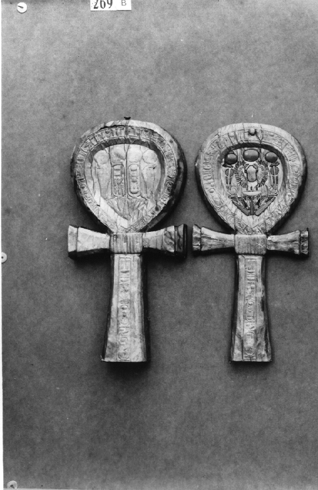The ankh symbol.
 The ankh was used as
an emblem and appears as one of the most powerful cultural and
religious symbols of Pharaonic Egypt. It outlived the fall of Ancient Egyptian culture and
occurred even on Christian (Coptic) monuments, probably because its shape is similar
to the Christian cross. The ankh was also a sign in monumental
hieroglyphic as well as the cursive (hieratic, demotic) writing with the phonetical value
*ankh.
The ankh was used as
an emblem and appears as one of the most powerful cultural and
religious symbols of Pharaonic Egypt. It outlived the fall of Ancient Egyptian culture and
occurred even on Christian (Coptic) monuments, probably because its shape is similar
to the Christian cross. The ankh was also a sign in monumental
hieroglyphic as well as the cursive (hieratic, demotic) writing with the phonetical value
*ankh.
The Egyptian word ankh means "life", "to live". This meaning already explains
the high symbolic value of the sign. The pictorial sign ankh represents originally
some kind of loop, although probably not a sandal-strip as occasionally assumed. One may
speculate about the significance of knots as symbols, but this "etymological" origin was
probably irrelevant for most Egyptians.
The
scene with a god presenting ankh to Pharaoh's nose (i.e. Pharaoh as the representative
of mankind) was depicted from the early third millennium onwards. So ankh-life was
seen as a gift of the gods for
mankind. It was not restricted to one specific god, and some gods were called "lord of life". The
concept of ankh was particularly relevant
in the sacral sphere (temple-scenes and funerary texts). It was also used in wishes in
letters ("might you live ...") or in oaths ("as Pharao NN lives for me ..."). There are
thousands of representations of ankh, not only in writing or in pictures, but even in the
form of ankh-shaped objects, especially mirrors or mirror-cases, such as those from the
tomb of Tutankhamun.
The picture shows two mirror-cases from the tomb of Tutankhamun. Detail of H. Burton
photo.
1713. Copyright Griffith
Institute, Ashmolean Museum, Oxford.
© Ludwig Morenz 2001
Back to The Sphinx Nose.
 The ankh was used as
an emblem and appears as one of the most powerful cultural and
religious symbols of Pharaonic Egypt. It outlived the fall of Ancient Egyptian culture and
occurred even on Christian (Coptic) monuments, probably because its shape is similar
to the Christian cross. The ankh was also a sign in monumental
hieroglyphic as well as the cursive (hieratic, demotic) writing with the phonetical value
*ankh.
The ankh was used as
an emblem and appears as one of the most powerful cultural and
religious symbols of Pharaonic Egypt. It outlived the fall of Ancient Egyptian culture and
occurred even on Christian (Coptic) monuments, probably because its shape is similar
to the Christian cross. The ankh was also a sign in monumental
hieroglyphic as well as the cursive (hieratic, demotic) writing with the phonetical value
*ankh.